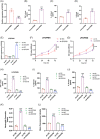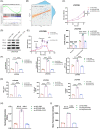DOCK8 inhibits the immune function of neutrophils in sepsis by regulating aerobic glycolysis
- PMID: 37647440
- PMCID: PMC10461417
- DOI: 10.1002/iid3.965
DOCK8 inhibits the immune function of neutrophils in sepsis by regulating aerobic glycolysis
Abstract
Introduction: This study endeavored to investigate the role of DOCK8 in modulating the immune function triggered by sepsis.
Methods: Expression of DOCK8 in the whole blood of sepsis patients and its enrichment pathways were assayed by bioinformatics. Pearson analysis was used to predict the relationship between glycolytic signaling pathway and its relevance to neutrophil function in sepsis. A sepsis mouse model was then built by performing cecal ligation and puncture treatment on male mice. Neutrophils were isolated, and their purity was tested by flow cytometry. Neutrophils were then stimulated by lipopolysaccharide to build a sepsis cell model. Next, quantitative reverse transcription polymerase chain reaction and CCK-8 were applied to test the expression of DOCK8 and cell viability, western blot to assay the expression of HK-2, PKM2, and LDHA proteins, ELISA to measure the concentrations of TNF-α, IL-1β, and IL-6, Transwell to detect the chemotaxis of neutrophils and flow cytometry to detect the phagocytic activity of neutrophils. Finally, in different treatment groups, we used Seahorse XF 96 to analyze the extracellular acidification rate (ECAR) of sepsis cells and used enzyme-linked immunosorbent assay to detect the contents of pyruvic acid, lactic acid, and ATP in sepsis cells.
Results: DOCK8 was downregulated in sepsis blood and activated neutrophils. Aerobic glycolysis was positively correlated with sepsis. Activated neutrophils promoted the expression of inflammatory factors TNF-α, IL-1β, and IL-6. Low expression of DOCK8 facilitated the proliferation, chemotaxis, and phagocytic activity of sepsis cells and promoted the expression of inflammatory factors. Bioinformatics analysis revealed that DOCK8 was enriched in the glycolytic signaling pathway. Low expression of DOCK8 induced ECAR, promoted the protein expression of HK-2, PKM2 and LDHA, and favored the increase of pyruvate, lactate, and ATP contents. While 2-DG treatment could restore these effects.
Conclusion: DOCK8 may inhibit sepsis-induced neutrophil immune function by regulating aerobic glycolysis and causing excessive inflammation, which helps to explore potential therapeutic targets.
Keywords: DOCK8; aerobic glycolysis; immune function; neutrophils; sepsis.
© 2023 The Authors. Immunity, Inflammation and Disease published by John Wiley & Sons Ltd.
Conflict of interest statement
The authors declare no conflict of interest.
Figures




Similar articles
-
Immune effects of PI3K/Akt/HIF-1α-regulated glycolysis in polymorphonuclear neutrophils during sepsis.Crit Care. 2022 Jan 28;26(1):29. doi: 10.1186/s13054-022-03893-6. Crit Care. 2022. PMID: 35090526 Free PMC article.
-
Effect of heat-reinforcing needling on hypoxia-inducible factor 1α and glycolysis activity in rabbits with cold syndrome of rheumatoid arthritis.Zhen Ci Yan Jiu. 2024 Jun 25;49(6):585-593. doi: 10.13702/j.1000-0607.20230487. Zhen Ci Yan Jiu. 2024. PMID: 38897802 Chinese, English.
-
PKM2/STAT1-mediated PD-L1 upregulation on neutrophils during sepsis promotes neutrophil organ accumulation by serving an anti-apoptotic role.J Inflamm (Lond). 2023 May 2;20(1):16. doi: 10.1186/s12950-023-00341-2. J Inflamm (Lond). 2023. PMID: 37131151 Free PMC article.
-
ANKRD22 promotes M2 polarization in lung adenocarcinoma macrophages via the glycolytic pathway.Chem Biol Drug Des. 2024 Jan;103(1):e14445. doi: 10.1111/cbdd.14445. Chem Biol Drug Des. 2024. PMID: 38230786
-
MicroRNA-30a inhibits cell proliferation in a sepsis-induced acute kidney injury model by targeting the YAP-TEAD complex.J Intensive Med. 2023 Oct 11;4(2):231-239. doi: 10.1016/j.jointm.2023.08.004. eCollection 2024 Apr. J Intensive Med. 2023. PMID: 38681790 Free PMC article.
Cited by
-
Unraveling the role of LDHA and VEGFA in oxidative stress: A pathway to therapeutic interventions in cerebral aneurysms.Biomol Biomed. 2025 Jan 14;25(2):360-374. doi: 10.17305/bb.2024.10510. Biomol Biomed. 2025. PMID: 38829380 Free PMC article.
-
Identification of Glycolysis-Related Signature and Molecular Subtypes in Child Sepsis Through Machine Learning and Consensus Clustering: Implications for Diagnosis and Therapeutics.Mol Biotechnol. 2025 Feb 20. doi: 10.1007/s12033-025-01379-8. Online ahead of print. Mol Biotechnol. 2025. PMID: 39976858
References
-
- Fleischmann C, Scherag A, Adhikari NKJ, et al. Assessment of global incidence and mortality of hospital‐treated sepsis. Current estimates and limitations. Am J Respir Crit Care Med. 2016;193:259‐272. - PubMed
-
- Herrán‐Monge R, Muriel‐Bombín A, García‐García MM, et al. Epidemiology and changes in mortality of sepsis after the implementation of surviving sepsis campaign guidelines. J Intensiv Care Med. 2019;34:740‐750. - PubMed
-
- Liew PX, Kubes P. The neutrophil's role during health and disease. Physiol Rev. 2019;99:1223‐1248. - PubMed
Publication types
MeSH terms
Substances
LinkOut - more resources
Full Text Sources
Medical
Miscellaneous

